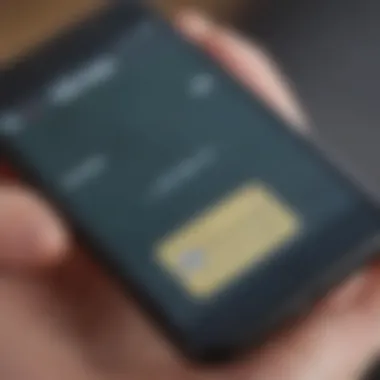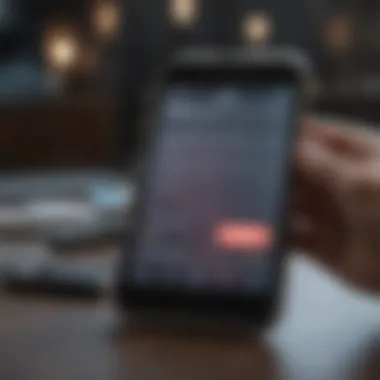Retrieve Your Old Phone Number on a New Device


Intro
Retrieving an old phone number on a new device is a common concern that many people face. This need arises for various reasons like switching to a newer phone, changing carriers, or upgrading to a different plan. Understanding the steps to follow can make this transition smoother. The following sections will cover methods to achieve this, along with the necessary details to pay attention to during the process.
Overview of Transferring Your Phone Number
Transferring your phone number involves several important aspects. In essence, it is the process of moving your existing number from one mobile device or carrier to another. This transition is beneficial for maintaining continuity in communication. Below are key features and benefits of transferring your mobile number:
- Key Features
- Purpose and Benefits
- Seamless transition from old to new device
- Retention of existing contacts and accounts linked to the number
- Flexibility in switching between different service providers without losing your number
- Allows for consistent communication without confusion
- Avoids the hassle of updating personal and professional contacts with a new number
- Can help maintain accounts linked to your old number, such as banking and social media
Understanding Different Methods for Retrieval
There are various methods to retrieve your old phone number on a new device. Each comes with its own set of procedures and requirements. Some common methods include:
- SIM Card Transfer: This is the most straightforward method where you simply insert the old SIM card into the new device.
- Porting Between Carriers: If you switch carriers, you can generally port your existing number through the new provider.
- Contacting Customer Support: If you encounter issues, contacting the customer service of your carrier can help clarify the steps.
Application Process for Retrieving Your Number
To effectively transfer your phone number, follow these steps:
- Check Eligibility: Confirm that your old number is eligible for transfer. Most numbers are eligible unless they are deactivated or tied to a contract.
- Gather Necessary Information: You may need your account number, PIN, or password from the old carrier.
- Start Transfer Request: Initiate the transfer process via the new carrier’s website or app. You can also visit a retail store for assistance.
- Complete Verification: Follow instructions to complete identity verification for security purposes.
- Wait for Finalization: It might take some time for the porting to complete. Monitor the process via notifications from the new carrier.
Common Mistakes to Avoid
When transferring your number, it’s important to sidestep common pitfalls:
- Not confirming eligibility of the old number.
- Forgetting to check whether the new carrier supports the old number.
- Failing to gather necessary information beforehand.
Tips for Successful Retrieval
- Double-check Information: Ensure all details like account number and PIN are accurate.
- Start the process during business hours: This can help you get immediate assistance if needed.
- Backup Contacts: Save essential contacts in cloud services or through other means to avoid loss during the transfer.
Finale
Understanding the Process
Retrieving an old phone number is a task that many individuals will encounter at some stage, particularly when upgrading to a new device. Understanding the process behind this task is crucial for a smooth transition. This section addresses the key elements and benefits associated with porting a phone number, as well as considerations that might arise during the process.
What Does Porting a Number Mean?
Porting a phone number refers to the process of transferring your existing phone number from one carrier to another. This allows users to maintain their established phone number, which is often tied to personal and professional contacts. The porting process involves specific procedures that vary by carrier but generally includes verifying your identity with both the old and new carriers.
Successful porting means that the phone number remains active, and you avoid the hassle of informing contacts about a new number. The porting process is facilitated through number portability regulations, ensuring that your number stays intact despite the change in service providers. Understanding this ensures that users approach the porting process with clarity.


Why Would You Want Your Old Number?
Maintaining your old phone number can serve numerous practical benefits. Many individuals develop a certain level of attachment to their contacts associated with a particular number. Additionally, retaining an old number provides continuity in personal and professional communications.
- Familiarity: Friends, family, and colleagues recognize and remember the number.
- Professional Image: A consistent phone number can reinforce brand identity for businesses.
- Financial Security: Existing accounts linked to the old number often require the number for verification or recovery options.
- Avoiding Missed Connections: Starting over with a new number can risk missing important calls or messages from people who haven’t updated their records.
These reasons highlight the significance of porting rather than changing phone numbers entirely, underscoring the importance of understanding this transition method.
Preliminary Requirements
Before diving into the process of retrieving your old phone number, it is crucial to understand the preliminary requirements. These requirements act as the foundation for a smooth transition between devices. Addressing them ensures that you avoid common pitfalls that may delay or complicate retrieving your number. Fulfilling these prerequisites makes the overall process much more efficient and helps mitigate any unforeseen issues.
Ensure Active Account Status
Ensuring that your account is active is vital. If you have not used your old account for a while, it may have been deactivated. Most carriers require that the account be in good standing for number portability. This means there should be no outstanding balances or service suspensions.
To check your account status, log into your carrier's website or contact customer service directly. Doing so can save valuable time in the porting process.
Check Compatibility
Not all devices support every type of phone number. Therefore, it is important to verify compatibility between your old number and the new device you wish to use. For instance, numbers from certain prepaid services might not be transferable to some postpaid setups.
You can check compatibility with the new device by reviewing the specifications directly from the manufacturer or consulting your carrier's customer service. Sometimes, limitations might not be immediately obvious, and it’s best to ensure the new phone supports the type of number you want to port.
It is crucial to verify both account status and device compatibility before initiating the porting process. This preparation can save time and frustration later on.
Methods to Retrieve Your Old Number
Retrieving your old phone number is a key step for many individuals when transitioning to a new device. Understanding various methods available for this process will help ensure a seamless transition. Each method offers unique advantages and considerations, depending on your situation. This section will explore these different strategies, allowing you to determine which approach best aligns with your needs.
Contact Your Old Carrier
One of the most direct methods to retrieve your old number is to contact your old carrier directly. Carriers such as Verizon, AT&T, T-Mobile, and Sprint typically have procedures in place for number porting. When contacting them, it is essential to provide relevant account information. This may include your account number, PIN or password, and other identifying information.
The importance of engaging with your old carrier lies in the potential challenges that may arise. For example, certain carriers may impose restrictions based on the type of account or service plan. Additionally, they can confirm whether your number is eligible for porting to your new carrier. Hence, understanding your old carrier's specific policies is crucial during this process.
Utilize Number Portability Services
Number portability services are facilitated by regulatory bodies in many regions. These services allow you to keep your phone number when switching providers. In the United States, for example, the FCC oversees the implementation of number portability. Utilizing these services can streamline the process of retrieving your old number.
Before initiating a port request, it is vital to check for any restrictions or requirements set by your new carrier. This information is often readily available on their websites or can be obtained through customer support. A critical consideration here involves timing; the porting process typically takes anywhere from a few hours to several days. Hence, it's advisable to plan your transition accordingly to minimize service interruptions.
Use Online Carrier Porting Tools
Many carriers provide online porting tools to simplify the process of transferring your old number. These tools can be an effective option for individuals who prefer a self-service approach. Typically, these online platforms require similar information as contacting the carrier directly, such as your account number and PIN.
Here are some advantages to using online porting tools:


- Convenience: Users can initiate the process at any time without waiting for customer service.
- User-Friendly Interfaces: Most tools are designed to walk users through the steps, making it relatively simple.
- Immediate Confirmation: Many online tools provide real-time updates regarding the status of your port request, allowing for easy tracking.
By leveraging these tools, you can efficiently manage the porting of your phone number, ensuring a quicker transfer to your new device.
Step-by-Step Process to Port Your Number
Porting your phone number is a significant step in the process of transitioning to a new device. It ensures that you can maintain your existing contacts and avoid the hassle of informing everyone about a new number. This section provides a careful outline of how to successfully port your number, emphasizing the necessary preparations and actions required to make the process seamless. Knowing what steps to follow will not only simplify the transition but also help you avoid any pitfalls that may arise during the porting process.
Gather Required Information
Before initiating the port request, it's vital to gather certain pieces of information. This preparation is key to a smooth porting experience.
Account Number
The account number associated with your old phone line is critical for initiating the port. It uniquely identifies your account and ensures that the new carrier can retrieve the correct information. The key characteristic of the account number is its specificity; it ties your phone number directly to your account.
This number is usually found on your billing statement or can be obtained from your current carrier's customer service. It is essential for avoiding delays during the porting process. However, it may have a disadvantage if misreported, leading to issues with verification and additional backtracking. Thus, it's prudent to double-check the number before proceeding.
PIN or Password
In addition to the account number, a PIN or password is often required for security measures. This is a safeguard that validates your identity and protects your account from unauthorized access during the porting process. The key characteristic of the PIN or password is its role in ensuring security, which is critical when services are being transferred.
You typically create this PIN or password yourself, but if you’ve forgotten it, you may need to contact customer service to retrieve or reset it. The unique feature of requiring a PIN adds another layer of protection, though it can be frustrating if you don't remember it, causing delays in porting.
Personal Identification
The last crucial piece of information is personal identification. Most carriers require some form of identification to confirm your identity and to prevent fraud. This can include a driver's license, social security number, or any government-issued ID. The requirement for personal identification is a standard practice that enhances the security and integrity of the porting process.
Verifying your identity ensures that the porting process proceeds smoothly. However, the challenge lies in ensuring you have the correct documents on hand, as any discrepancies can lead to complications. Having these documents ready will mitigate any potential hindrances that may arise.
Initiate the Port Request
Once you have gathered all required information, the next step is to contact your new carrier to initiate the port request. This step is crucial as it signals the beginning of the transfer process. Your new carrier will guide you through their specific procedures, which may vary between companies. It’s important to provide accurate and complete information to avoid delays.
Monitor the Porting Status
After initiating the request, monitoring the porting status is essential. Keep an eye on communication from both your old and new carriers. They may send updates or notifications regarding the progress of your number’s transfer. Knowing the status will help you understand the timelines and be prepared for any issues or delays that may arise.
Common Challenges and Solutions
Retrieving an old phone number on a new device can be difficult. A number of factors may complicate this process. It is crucial to recognize these challenges to prepare accordingly and find solutions that will ensure a smooth transition. Understanding the common obstacles is the first step in successful porting.
Carrier-Specific Limitations
One major challenge arises from carrier-specific limitations. Different service providers have varying policies and protocols for number porting. Some carriers may impose strict requirements, such as account activity or credit standing. It is essential to check the specific terms of your old and new carriers to avoid unexpected roadblocks. If you are only partly aware of these limitations, you risk delays or even denial of porting.
Here are some important points to consider:
- Active Account: Many carriers require the old number to be active before a port can be initiated.
- Time Limits: Some providers only allow porting for a specified duration after account closure.
- Eligible Numbers: Not all numbers, like virtual numbers, may qualify for porting. Knowing these details ahead of time can save you frustration.


Pending Charges and Fees
Another challenge involves pending charges and fees associated with your old account. Carriers frequently charge final bills including early termination fees or outstanding balances. Before even thinking about porting, ensure that all fees are settled with the previous carrier. If there are any unpaid balances when the port request is made, it may lead to complications.
Consider the following actions:
- Review Your Last Bill: Check for any outstanding charges that need to be cleared.
- Contact Customer Service: Direct conversations with customer support can provide clarity on any remaining balances.
- Confirm Payment Processing: Ensure that all payments are processed before attempting to port your number.
Delays in Porting Process
Finally, delays in the porting process can be a significant source of anxiety for users. Factors leading to these delays can include incorrect information during the port request or overloads at the carrier's end. In some cases, carriers can take several days or even weeks to complete the porting. To mitigate such risks:
- Double-Check Your Information: Ensure details like account number and personal identification match exactly.
- Keep Track of Time: Monitor the porting process closely and reach out to customer service if it takes longer than expected.
- Have a Backup Plan: If the porting is not completed in a reasonable time, consider maintaining both devices temporarily.
Understanding the challenges and having a plan can lead to a more successful porting experience. Make the effort to stay informed about your carrier's protocols. Knowledge is a significant asset when navigating the complexities of retrieving an old phone number.
Post-Porting Considerations
After successfully porting your old phone number to a new device, there are vital considerations to ensure that the transition is fully seamless. This phase can be overlooked, but it holds significant value for maintaining connectivity and optimizing your phone experience. It is important to understand what steps to take post-porting, as these will ensure that everything functions as intended.
Confirm Service Activation
Confirming the activation of your service is the first step after porting your number. This is crucial because sometimes, despite having followed all the procedures, the activation may not occur automatically. First, check that you have access to your phone's network. You may initiate a simple call or text to verify that your phone number is operational. If you face any issues, reach out directly to your new carrier's customer service for assistance. Support is often available 24/7, so do not hesitate to contact them.
Additionally, after a successful port, you should receive a confirmation message. This message generally includes details about your service plan and guidelines on how to maximize your phone’s capability. It is wise to keep this information for reference. If you notice any discrepancies in your billing or features, inform your carrier immediately.
Update Contacts and Accounts
Post-porting, updating your contacts and accounts is also key. You need to ensure that all your important contacts are aware of your successful transition. Send out messages to your close contacts, informing them of your unchanged number. This step helps prevent any confusion when someone attempts to reach you and is still trying your old number.
Moreover, consider checkin in with various accounts linked to your phone number. Many services utilize your phone number as a form of identification or recovery method, such as social media platforms and online banking. Ensure that these accounts have your updated information to avoid getting locked out of important services due to verification issues.
In summary, taking the necessary post-porting steps helps ensure a smooth transition to your new device. Failing to confirm service activation and update your contacts and accounts can lead to unnecessary frustration. Thus, by focusing on these practical elements, you can maintain seamless connectivity and functionality with your old number on a new device.
Epilogue
Retrieving your old phone number is a critical process that can have several implications for your everyday communications. This conclusion section synthesizes the essential points discussed throughout the article and emphasizes their relevance.
Recap of Key Steps
The steps to successfully retrieve your old phone number have been clearly outlined. Here’s a summary:
- Understand the Process: Be aware of what porting a number entails.
- Preliminary Requirements: Ensure your account is active and check compatibility with the new device.
- Methods to Retrieve Your Old Number: You can contact your old carrier, make use of number portability services, or utilize online carrier porting tools.
- Step-by-Step Process: Gather all necessary information, initiate the port request, and monitor the status.
- Common Challenges and Solutions: Recognize potential barriers such as carrier limitations, pending fees, or delays.
- Post-Porting Considerations: Confirm that your service is active and update your contacts accordingly.
This recap is not just a list but a pathway to ensure that you navigate the transition with clarity and efficiency.
Final Thoughts on Porting Numbers
Porting your number is more than a mere technical maneuver; it represents continuity in a world where change is constant. Keeping your old number allows you to maintain established connections, which can be vital in personal and professional spheres.
As you embark on this process, consider the long-term benefits of retaining your old number. It safeguards your communication identity and reduces the frustration of having to inform contacts of a number change. Furthermore, understanding the nuances of porting can equip you with the knowledge to assist others in similar situations.
Remember, the journey might present challenges, but being prepared and informed transforms these potential obstacles into manageable steps. Engaging with your carriers constructively can often facilitate a smoother experience. With the information provided, you are now attuned to the operational landscape of number retrieval. This preparation ensures a confident transition to your new device.



